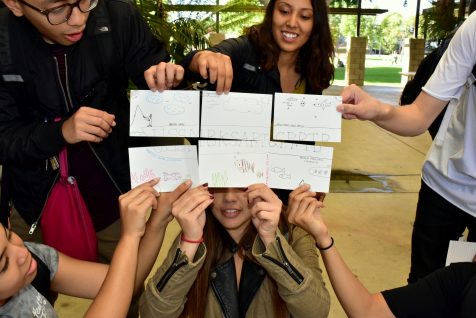Schedule
Need Help?
- Ask online
- Come to before class OH on Wed 11:30-12:30 @Robek’s / Coffee Bean umbrella tables
- I can go to AS-120 (AS building is next to The Beach Hut, next to The Library) after class on Wed, at 3:45 and help anyone with anything.
- Make an appointment to meetup another time

pix from your ID Card Teams last week are on Flickr! 🙂
Points on BeachBored
All points through Week 7 are now up on BeachBored. Be sure to check your points and know where you stand! So far we’ve had 372 points possible. Here’s how many points you should have to be on track for each grade level, and how many peeps in 1p / 2:30 are currently at each grade level:
A = 335 points – 57 / 49
B = 298 points – 5 / 5
C = 261 points – 1 / 2
D = 224 points – 0 / 0
F = 223 points – 2 / 6
- 1p GPA = 3.77
- 2:30 GPA = 3.47
Leaderboard
Top 5 @1pm:
- Hannah Adams, 458
- Stephanie Arciva, 445
- Maritess Anne Inieto, 427
- Joy Elizabeth Uba, 417
- Carlos Villicana, 417
Top 5 @2:30:
- Lydia Chang, 503
- Nathan Davalos, 495
- Jamie Van, 447
- Yesenia Hernandez, 446
- Adriana Maciel, 424
Cool Website OTW

Check out Nkechi Okoroma’s cool website with the scotch tape and pencils and “papers” that look like you wrote a paper! 🙂

EC: Brewery Art Walk
22-23 October, 11am – 6pm
breweryartwalk.com
Speaking of Artwalks, a big one is coming up. The Brewery is a former Pabst Blue Ribbon beer brewery that’s been converted into a giant artist live-work loft space. Hundreds of artists have spaces there and about 150 or so will open their studios for the artwalk weekend.
Extra Credit:
- Visit studios
- Chat with artists
- Take selfie w artist
- Write a thoughtful paragraph about their work
- Blog it
- 5 points EC / artist
- Up to 10 artists, so up to 50 points EC
- Post by next Sunday night, Oct 23.
Wk 8 – This Week!
- Art Talk Discussion – at the bottom of this post
- Activity – Sketching @CSULB Japanese Garden
- Artist Conversation – none this week
- Classmate Conversation – @CSULB Japanese Garden, normal format
Classmate Questions this week:
- What is a piece of art, of any medium, that you would like to share with everyone? Why do you like it and why do you think others should experience (read, see, listen to, etc.) it? – Carlos
- Would you be supportive of your child wanting to pursue an art career? Why or why not? – Anonymous
- Open your phones to the 1st page. What apps do you both have? What apps are different? Discuss! – Glenn
Write next week’s Classmate Question OTW here: Classmate Question OTW
Artist Conversations
- Lots of great writing! TY!
- Some of you are getting pretty thin in your writing. Some barely eaked out full credit, many got “13” points – see rubric
- Peeps who use The Artist Conversation Template tend to score higher.
- Here’s a great sample from Hannah: Wk. 7 – Artist Conversation – Nathaniel Paderanga
Art Talk OTW
- 3 Million Years of Art History
- Joseph DeLappe
- Mahsa Soroudi
- The Mind in the Cave
- Graffiti Writing: Bomb It
- Classical Greece & Rome
- Renaissance & Baroque
- 19th Century
Interactive Art History Timeline
If you want to play with the Art History Timeline that you see me using in these talks, you can get your very own copy & the Freemind software to view, modify, or make your own, here:
Extra Credit?

- Go visit the Getty Center in Westwood. Parking is $15/car. Admission is free for everyone. Take a picture of yourself w Jacques-Louis David’s 1818 painting The Farewell of Telemachus and Eucharis blog it. +20 EC.
- Want more EC? Do a recreation of The Farewell of Telemachus & Eucharis with your boyfriend/girlfriend, brother/sister, classmate, etc, and add it to your blog post for up to another +20 EC.
- Post by next Sunday night, Oct 23.


Comments? Questions? What great art did you see, make, or experience today?